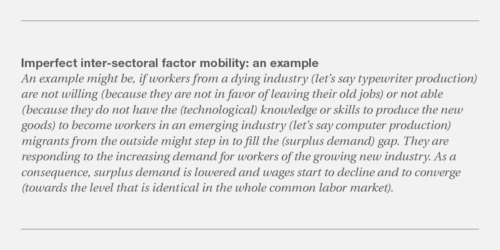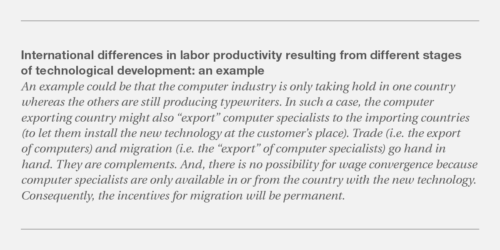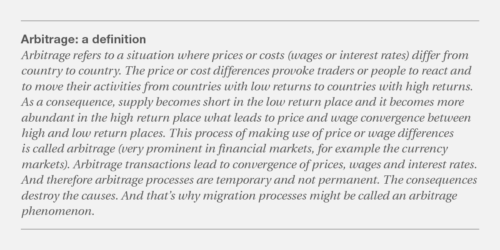highlights #1.2
EU Migration to Switzerland: Why Did the Forecasts Fail?

Thomas Straubhaar
Institute of International Economics, University of Hamburg
How many workers from the European Union (EU) might move to Switzerland, once the borders are opened up and legal and pecuniary obstacles to cross-border movements of Swiss and EU citizens are removed? In 1999, my forecast was, that there was hardly any theoretical justification why an integrated labor market between relatively homogeneous economies should lead to strong migration flows. Economic theory rather suggested that trade and capital mobility are efficient substitutes to labor mobility.
A net balance of 10,000 EU workers (from the “old EU-15 before the EU East enlargement) per year at the maximum were expected to immigrate into Switzerland(1). Nowadays, we know, that the forecast has failed. Migration flows from the EU-15 to Switzerland have been much stronger than expected in 1999. Actually, after the bilateral agreement between Switzerland and the EU has been signed in 1999 and became effective in 2002(2) , net migration flows have exceeded the 10,000 threshold by far, in certain years even by a substantial dimension (see figure 1).
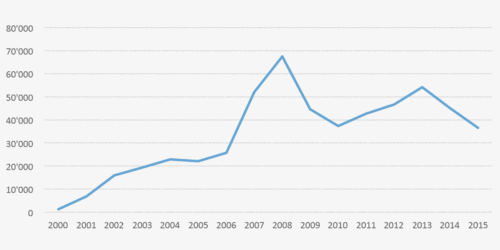
Figure 1: Net Migration Flows from Core-EU to Switzerland between 2000 and 2015 (Core EU is Germany, France, Italy, Spain, Netherlands, Austria, Portugal and UK); Source: Swiss Federal Statistical Office (3)
In total, between 2002 and 2015 more than a half a million EU citizens have migrated to Switzerland. And even if not all of them were or have become “workers” and have stayed as “non-working” family members, the average net balance of workers was in the average of about 30,000 and thus far above the forecasted 10,000.
As figure 2 shows, most of the EU-citizens came from the neighboring countries. Especially the Germans reacted extremely elastic to the new freedom of migration and moved to Switzerland.(4) Between 1991 and 2001 the average annual migration flow from Germany to Switzerland was a little more than 3,000. Between 2002 and 2011 it increased to about 17,500. Since then, however, it has declined to less than 10,000 people.
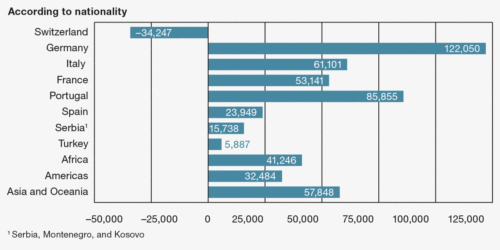
Figure 2: Aggregated Migration Balance, 2008–2015 According to Country of Origin; Source: Swiss Federal Statistical Office (5)
Thus, the question arises as to why the forecasts about the effects on migration flows from the EU to Switzerland failed. Basically, three answers might be given: a) inappropriate theory, b) inappropriate empirical extrapolation and c) inappropriate conclusions. In what follows, a short discussion of these three sources of failure will be given.
Inappropriate Theory?
The theoretical approach that I have applied to forecast the potential migration flows from the EU to Switzerland has been in the tradition of a neo-classical model. Therefore, building a single market with an integrated common labor market was expected to accelerate a trend towards wage convergence. In a neo-classical setting, the factor price equalization theorem postulates that it is just a matter of time until – sooner or later – real wage rates and the capital interest rates are equalized across integrated common markets as a result of trade, labor migration and capital movements.(6) And once convergence is reached, economic determinants for migration cease to exist.
Therefore, migration is just a temporary factor on the way towards a situation with equal standards of living everywhere and, thus, with no economic incentives for migration. In such a theoretical framework, the consequences of migration (i.e. the wage convergence) destroy the determinants of migration (i.e. the wage differences). Consequently, opening up borders and establishing free movement in an integrated labor market is the most clever policy option, because it accelerates the convergence process. More migration in the short run leads to less migration in the long run.
“More migration today, slows down migration tomorrow. And, a pro-migration policy becomes the most effective anti-immigration policy.”
In a neo-classical model of international economics, migration and/or cross-border capital movements and/or commodity trade can equalize wages simultaneously. Factor price equalization (i.e. wage convergence) then becomes consistent with an infinite number of combinations of factor movements (i.e. labor migration and capital transactions across countries) and commodity flows. The tendency towards factor price equalization (i.e. wage convergence) can be reached either by capital movements only, or labor mobility only, or goods trade only, or every combination of labor and capital movements and commodity flows.
A determination among these different combinations on a priori grounds is at least difficult probably even impossible. If relative factor endowments – let’s compare for example Switzerland and the EU – were sufficiently close, international commodity trade alone would produce factor price equalization and could completely substitute for international migration of labor (and also cross-border capital movements). If relative endowments were too dissimilar between – let’s say – Switzerland and the EU, international commodity trade alone would not lead to a factor price equalization (i.e. wage convergence). And consequently, there would be a strong(er) incentive for migration from countries with lower wages (let’s say the EU) to countries with higher wages (let’s say Switzerland).
Taking a neo-classical model to explain migration flows from the EU (as the “poor” country with “low” wages) to Switzerland (as the “rich” country with “high” wages”), three basic reasons might explain, why it is migration and not international trade or cross-border capital movements that drive the convergence process:
First, migration might be a reaction to existing trade impediments [as in Mundell’s case(7)] or a reaction to the physical non-tradability of certain goods, which prevent “goods for goods” trade [as in Krauss’s case(8)]. In this sense, labor migration is a substitute, whole or partial, for international commodity trade.
Second, migration might be a substitute for an imperfect inter-sectoral factor mobility [as in Dixit and Norman’s case(9)].
Third, labor migration might reflect a reaction to international differences in labor productivity resulting from different stages of technological development. In that case, commodity trade and international labor migration are complements rather than substitutes [as in Markusen’s case(10)].
Obviously enough it turned out that Switzerland and the EU were more different than I supposed. Production was not characterized by the same technology and identical productivity. The wage divergence was not just a matter of different factor endowments. Much more, it was determined by imperfect competition, different production technology and probably even more important by fundamental differences in the political and legal factors such as political stability, monetary independence (i.e. Switzerland not being a member of the Euro area) and legal autonomy (i.e Switzerland not being a member of the EU). This means: Migration from and to Switzerland was rather of the Markusen type (described above). In this case, there is no tendency towards wage convergence but rather towards wage divergence (or at least permanent wage differences).
“Consequently, migration patterns between Switzerland and the EU were not well mirrored in a neo-classical framework – assuming a trend towards factor price equalization.”
It would have been more adequate to apply a model that allows for dynamic processes leading to divergence rather than convergence. In such a setting, migration consequences do not lead to a slowing down of migration determinants. Rather, they might lead to an acceleration and to core-periphery outcomes with strong migration movements from the weaker (that is the EU) to the stronger economy (that is Switzerland).
Inappropriate Empirical Extrapolation?
To estimate the consequences of a removal of border restrictions and an establishment of a common labor market with no impediments for migration movements from the EU to Switzerland, an extrapolation of historical evidence into the future could have been used. However, there was no such historical evidence available at all! Such a fundamental regime change from a more or less fully regulated restrictive immigration system towards an “open door” for EU citizens was so dramatic that the Lucas-critique prohibited a simple extrapolation of historical behavior.(11) The Lucas-critique is “that any change in policy will systematically alter the structure of econometric models. … it implies that comparisons of the effects of alternative policy rules using current macro econometric models are invalid regardless of the performance of these models over the sample period or in ex ante short-term forecasting.”(12)
The Lucas-critique refers to the level of consistency and invariance over time and space. It is about the severely limited correctness of an extrapolation from past migration patterns to expected migration behavior and it is about the restricted possibilities of applying empirical migration experiences from one area to another.
“In all forecasts, a double extrapolation problem remains: time and space will never be the same again! And with regard to the migration regime change between Switzerland and the EU of 2002, a simple extrapolation seemed not to be valid at all.”
Therefore, another approach has been used to overcome the Lucas critique. I searched for some earlier migration regime changes. And I looked at historical evidence with respect to the free movement of people within the European Communities. With such a procedure, I hoped to catch the elasticities of migration behavior towards migration regime changes. I assumed that at this time (i.e. around 2002) the European migration past had some explanatory power for predicting the future of Swiss-EU migration.
In a nutshell, the migration in Europe was (and actually, still is!) demand-determined. EU citizens have mostly moved abroad if and only if an employer in another EU country offered them a job on a contractual basis. Sometimes (with an increasing tendency) employers were sent abroad by their own companies, a phenomenon called internal labor market movements. Why should they change their behavior in the case of (free) migration to Switzerland after 2002?
Obviously, they did. EU-citizens, especially Germans, had a much stronger propensity to migrate to Switzerland than they had before (when they could have moved to all other EU countries without restrictions). The analogy did not hold because divergence instead of convergence in the economic standard of living was the outcome of the establishment of a common labor market between Switzerland and most parts of the EU.
Further reasons for the underestimation of migration reactions in my analogy were that language and cultural differences had been smaller than expected and therefore the propensity to migrate from the neighborhood (especially Germany) to Switzerland was stronger than anticipated – because individual adjustment costs were much lower than expected.
Finally, the analogy neglected business cycle effects. Indeed, the Swiss economy reacted more flexibly to the short-term challenges than the EU economies. Therefore, the individual micro-economic effects of firms and workers to the business cycles (i.e. the labor demand and supply reactions) stimulated instead of curbed migration incentives to Switzerland. Moving to Switzerland became more attractive for Germans and other neighbors.
“My empirical forecast was rather accurate in qualitative regards but wrong in quantitative terms.”
It predicted (correctly) that most additional immigrants would come from the neighboring countries. And it argued that the relatively strong immigration potential from the neighborhood was not so much the result of differing per capita incomes. Income and unemployment did not and do not differ so much between Switzerland and its neighboring regions (Alsace, Baden-Württemberg, Bayern, Bozano, Franche-Comté, Haute-Savoie, Lombardia, Piemonte, Tirol, Vorarlberg). The migration flows from the neighborhood to Switzerland have rather been seen as an inherent consequence of merging regions and integrated labor markets on both sides of the border. This form of migration between highly developed countries hardly differs from intra-country migration. The concept of “mobility” rather than “migration” seemed therefore more appropriate.
Inappropriate Conclusions?
Labor market effects were and are considered for Switzerland as being the probably most important consequences of a bilateral treaty with the EU. Therefore, the conclusion that free migration and open access for EU citizens to the Swiss labor market do not lead to substantially stronger immigration flows was just wrong. According to economic theory suggesting that trade and capital mobility will be efficient substitutes to labor mobility, I have expected that rather production would move to people than people move to the production sites in Switzerland.
Probably the most important reason for the underestimation of migration flows to Switzerland was the underestimation of the stability and strength of the Swiss economy during and after the financial market crisis and in times, when the EU was concerned about the future existence and coherence of the Euro area. Strong recession of the World economy and enduring Euro turbulences made the Swiss economy look as a stable rock in times of uncertainty.
But even under these macroeconomic circumstances, most migration was demand-driven not supply-given.
“EU workers moving to Switzerland had a job offer and they did not come and stay as unemployed people. The relatively well performing, prospering Swiss economy attracted more people than expected.”
Most of the immigrants were “white-collar” workers with skills and knowledge that was scarce but needed in the Swiss labor market. The traditional blue-collar (Gastarbeiter) migration did not play an important role in the EU-Swiss migration flows in the last decade. The EU-Swiss migration pattern rather reflected an intra-industrial mobility of highly skilled workers and managers. This modern form of migration is mainly the result of cross-border links of regional labor markets. To a lesser extent it is therefore an arbitrage phenomenon (related to the convergence hypothesis mentioned above).
It rather is a strategic element in international competition to exploit comparative cost advantages – and therefore it is also in the benefit of the Swiss economy.
“Before the financial market crisis, demand-driven immigration in Switzerland influenced the per capita development positively instead of negatively – afterwards, it did not harm the average standard of living.”
Figure 3 shows that between 2002 and 2007 the Swiss economy was characterized by strong real GDP growth, slow population growth, and therefore strong GDP per capita growth. After the world financial market crisis and the “great” recession the Swiss economy recovered (relatively faster than the EU neighborhood). Now the characteristics were: strong real GDP growth, strong population growth (as a consequence of strong immigration), and more or less stable GDP per capita. Even if (much more) econometric analysis has to be done to check for causalities, sensitiveness and robustness, it seems that the demand-driven immigration before the financial market crisis influenced the per capita development positively instead of negatively, and that afterwards it did not harm the average standard of living in Switzerland.

Figure 3: GDP (real), Population and GDP per Capita (real) Development in Switzerland between 2000 and 2015 (All data in index form with the year 2000 = 100) ; Source: Swiss Federal Statistical Office (13). Own calculations.
—
(1) see Straubhaar, 1999
(2) see Schweizerische Eidgenossenschaft 2015, 1999
(3) Bundesamt für Statistik BFS, 2016a
(4) for the data see Bundesamt für Statistik, 2016a
(5) Bundesamt für Statistik BFS, 2016b
(6) see Samuelson, 1948; Mundell, 1957
(7) Mundell, 1957
(8) Krauss, 1976
(9) Dixit and Norman, 1980
(10) Markusen, 1983
Of course, Markusen’s case means that the basic assumption of the neo-classical models of international economics are not fulfilled anymore. The more international factor-price differences are not the consequences of factor endowment differences but determined by such factors as internationally different returns of scale, imperfect competition, differences in production and factor taxes, and different production technology, the more probable it is that international trade and international labor migration would be complements rather than substitutes. And consequently, migration would not be slowed down but rather accelerated in case of the establishment of a common labor market with no restrictions for labor to move from one country to the other.
(11) It could be tried to overcome this fundamental methodological problem by the inclusion of so-called country-specific effects. In most econometric forecasts the country-specific aspects are captured by a country-specific intercept, which remains constant over time. However, it remains more than crucial how the country-specific intercept is defined and applied to the free migration between the EU and Switzerland because there was absolutely no historical experience for such a migration regime.
(12) Lucas, 1976, p. 41
(13) Bundesamt für Statistik, 2016c,d
References
Bundesamt für Statistik BFS (2016a): Statistik Schweiz, Internationale Wanderungen der ständigen Wohnbevölkerung nach Staatsangehörigkeit, Geschlecht und Alter 1991–2015; (je-d-01.05.04.01.01); Download, 24 September 2016.
Bundesamt für Statistik BFS (2016b): Statistik Schweiz, Internationaler Wanderungssaldo 2008–2015 (Diagramm). (gr-d-01.05.04.01.01); Download, 24 September 2016.
Bundesamt für Statistik BFS (2016c): Statistik Schweiz, Ständige Wohnbevölkerung nach Staatsangehörigkeit und Geschlecht 1950–2015, (su-d-01.01.01); Download, 24 September 2016.
Bundesamt für Statistik BFS (2016d): Statistik Schweiz, Bruttoinlandprodukt pro Einwohner 1990–2015 (je-d-04.02.01.05); Download, 24 September 2016.
Dixit, Avinash K., and Victor Norman. Theory of International Trade. Cambridge: Cambridge University Press, 1980.
Krauss, Melvyn B. “The Economics of the ‘Guest Worker’ Problem: A Neo Heckscher-Ohlin Approach.” Scandinavian Journal of Economics 78 (1976): 470–476.
Lucas, Robert E. “Econometric Policy Evaluation: A Critique.” In Carnegie-Rochester Conference Series on Public Policy 1 edited by Karl Brunner, and Allan H. Meltzer. 19–41. Amsterdam: Elsevier, 1976.
Markusen, James R. “Factor Movements and Commodity Trade as Complements.” Journal of International Economics 14 (1983): 341–356.
Mundell, Robert A. “A Theory of Optimum Currency Areas.” American Economic Review 51 (1961): 657–665.
Samuelson, Paul A. “International Trade and the Equalisation of Factor Prices.” Economic Journal 58 (1948): 163–184.
Schweizerische Eidgenossenschaft (2015): Abkommen zwischen der Schweizerischen Eidgenossenschaft einerseits und der Europäischen Gemeinschaft und ihren Mitgliedstaaten andererseits über die Freizügigkeit (Abgeschlossen am 21. Juni 1999, von der Bundesversammlung genehmigt am 8. Oktober 1999, in Kraft getreten am 1. Juni 2002, Stand am 8.6.2015.
Straubhaar, Thomas. “Integration und Arbeitsmarkt: Auswirkungen einer Annäherung der Schweiz an die Europäische Union.” Beiträge zur Wirtschaftspolitik Nr. 3, Bern: Schweizerisches Bundesamt für Wirtschaft und Arbeit, 1999.
Further Readings
Eurofound. Labour Migration in the EU: Recent Trends and Policies. Luxembourg: Publications Office of the European Union, 2014.
Kahanec, Martin, Mariola Pytliková, and Klaus F. Zimmermann. “The Free Movement of Workers in an Enlarged European Union: Institutional Underpinnings of Economic Adjustment.” IZA Discussion Paper No. 8456 (2014).
Schweizerische Eidgenossenschaft (2016): Aktuelle Studien zur Personenfreizügigkeit FZA


